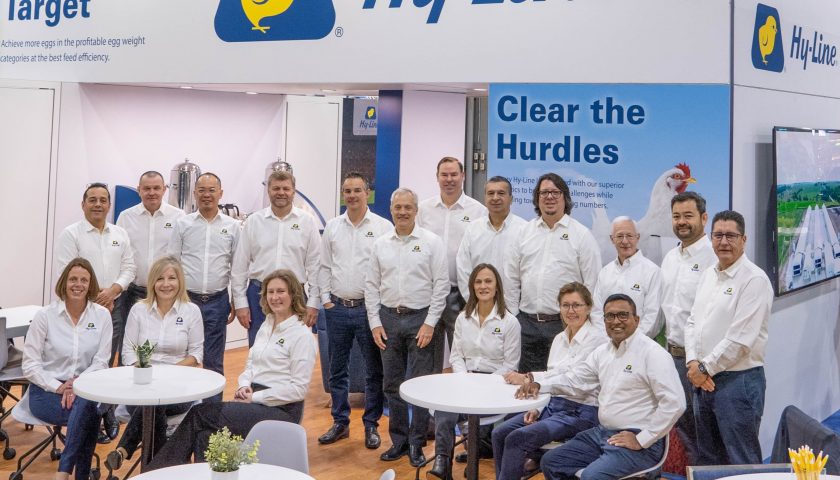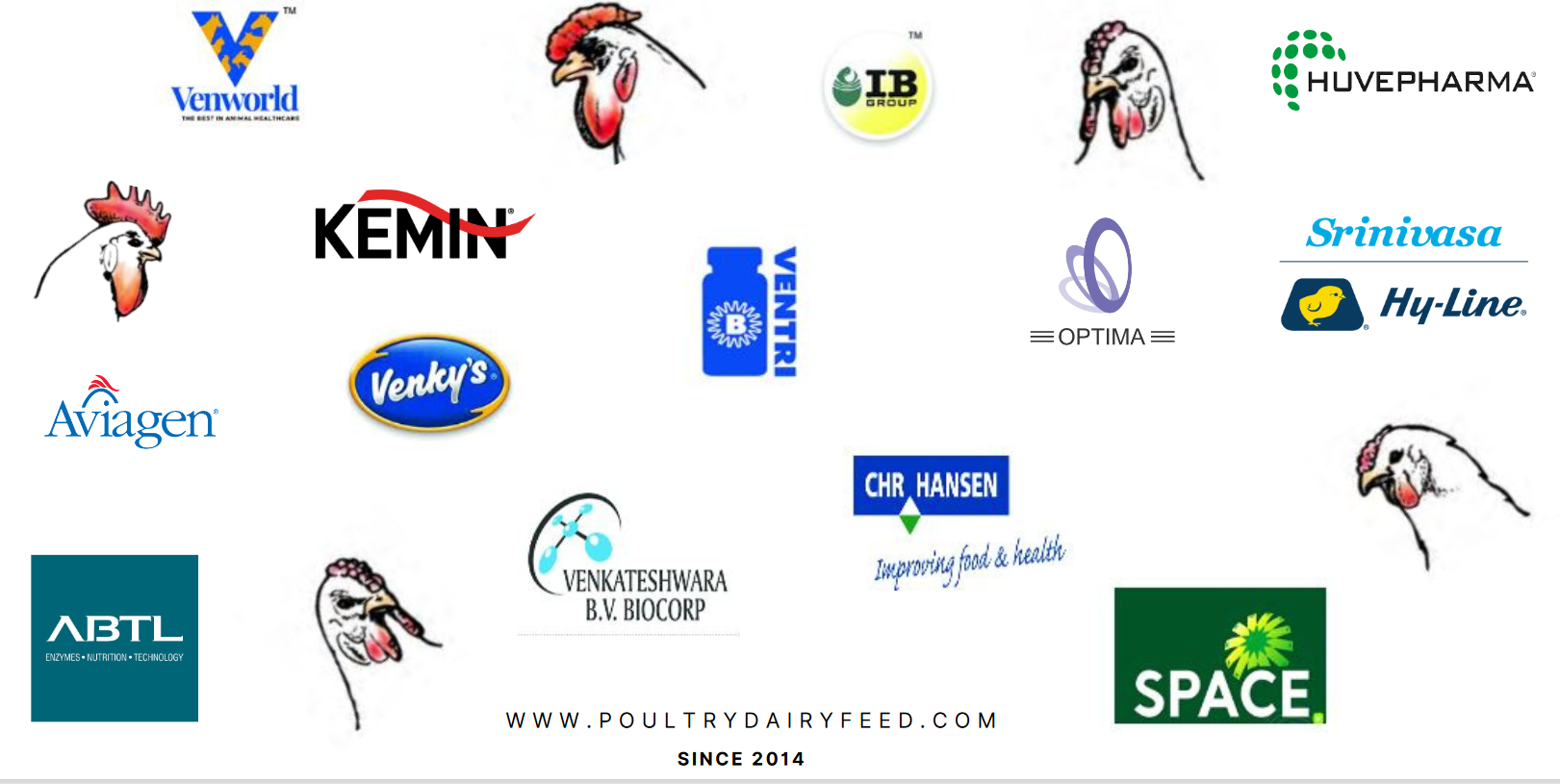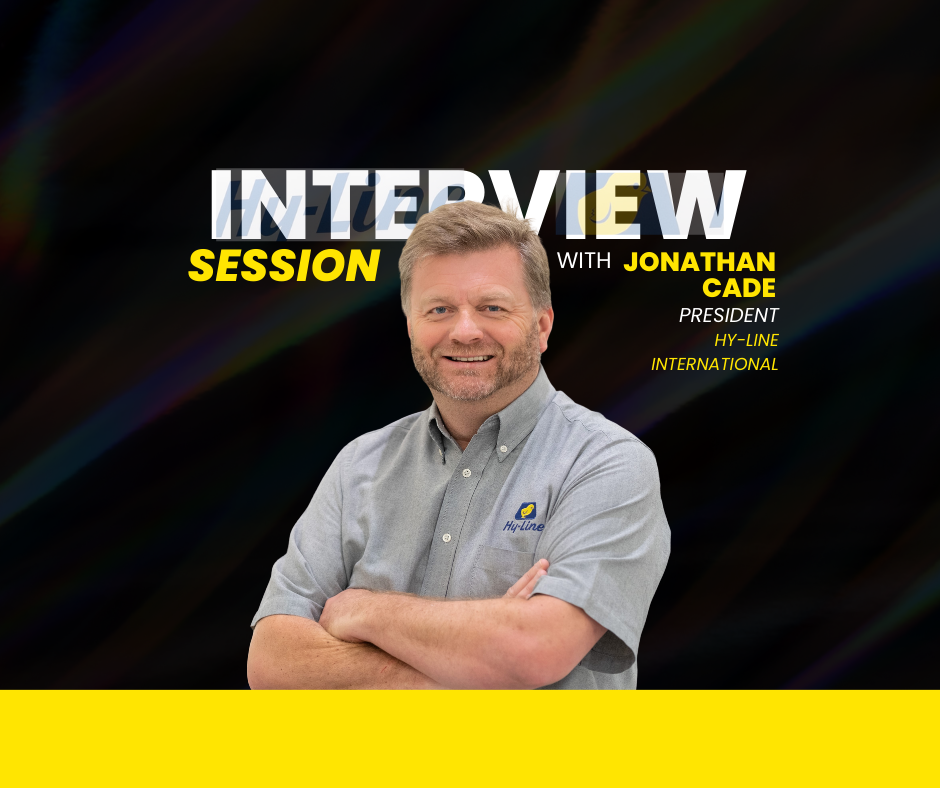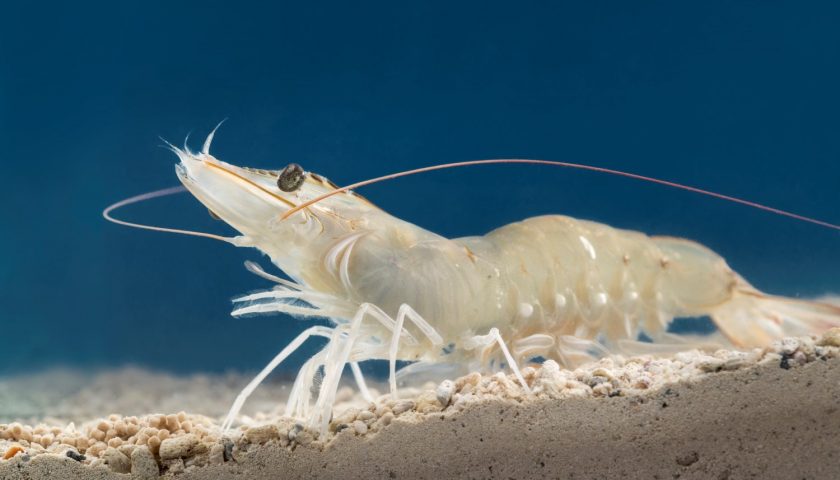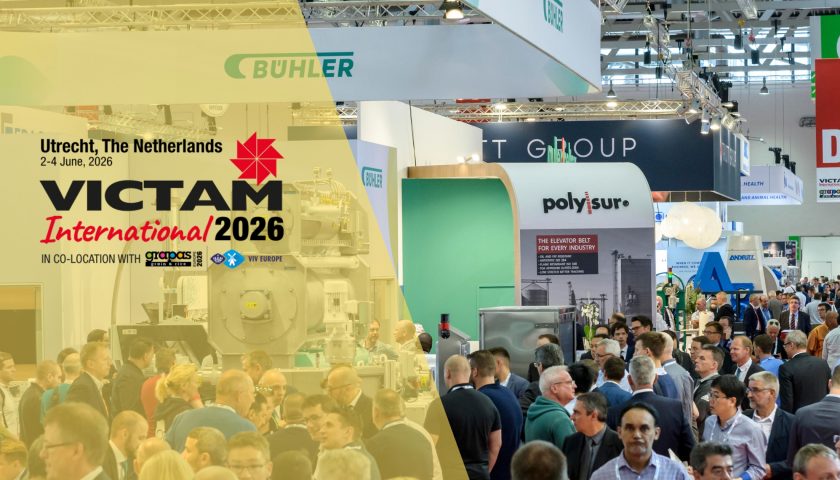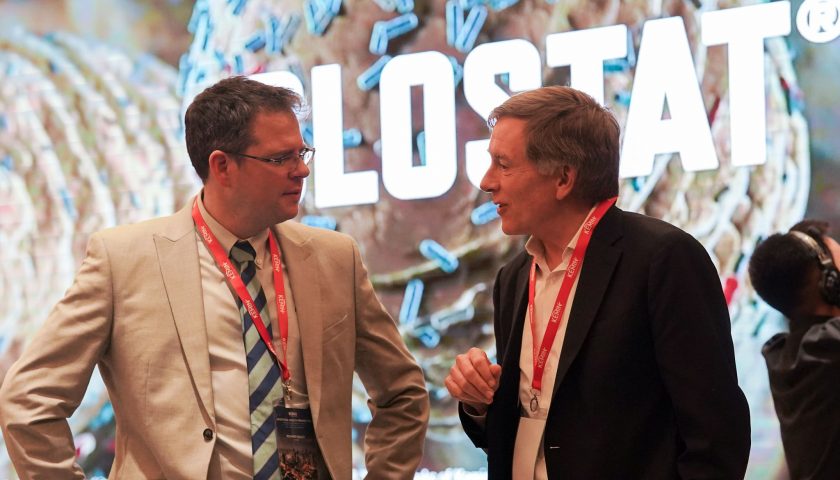At the helm of Hy-Line is Mr. Jonathan Cade, a visionary leader, President – Hy-Line International, known for his deep understanding of the poultry industry and commitment to advancing genetic technology. Under Cade’s leadership, Hy-Line has continued to develop and introduce new breeds that excel in traits such as egg production, feed efficiency, and disease resistance. In the interview with PDF Newspoint, Jonathan discussed the strategic partnerships and research collaborations of Hy-Line’s genetic innovation and its enabled producers to maximize customers profitability while maintaining high standards of animal welfare and environmental sustainability.
Question : Could you please share with us some information about yourself and your journey with Hy- Line?
Jonathan Cade : I joined Hy-Line UK Ltd in April 2009 from Cobb Europe. I was responsible for the Parent Stock export business from the Millennium hatchery, UK to all Europe, Middle East, CIS/Russia, Africa and Indian Sub-continent countries. In 2012 and to this day I was appointed as Hy-Line International President based in Des Moines, Iowa, USA. Responsibilities were to oversee the R&D, global GP and PS production and exports of breeding stock and customer support globally. Recent responsibilities are to lead the commercial activities and business development in markets around the world, Asia, China, Mexico, India, and Africa.
Question : How does Hy-Line place emphasis on animal welfare and ethical considerations within its breeding programs?
Jonathan Cade : The welfare of the birds under our care from the pedigree level down through the multiplication flocks of grandparent and parent stock with our distributors and in our interaction with
commercial layers is of the utmost importance to Hy- Line International. The health and well-being of our Hy- Line birds is paramount. All new employees are immediately trained and educated on their
responsibilities toward this end and the company requires annual reminders on this training for all employees.
This dedication to welfare is reflected in our breeding program. Livability is the most important welfare consideration and Hy-line is well known for enhancing the overall robustness and resistance to field
stress and disease challenges of our birds. Hy-Line is known to have the best livability in the industry in all of our white, brown and tint-egg lines. We focus extensively on our birds’ social behavior and
temperament as we develop hens that will thrive in both cage and cage-free environments. Today cage-free production has grown to surpass 15% of the world’s egg production. Social behaviors are extremely important in cage-free systems as the birds may be exposed to bright light, interaction with many more birds, and as it becomes a more widespread practice in non-cage production to withhold beak treatments, developing birds with high sociability attributes is even more important. Hy-Line develops birds with excellent social behaviors with a very low susceptibility to negative social behaviors. Hy-Line has invested in open-sided, cage-free pedigree housing in Mexico to directly study these behaviors and promotes stronger nesting behavior. Hy-Line watches trends in the market in terms of
production systems – cage vs. cage-free– and works to prepare our hens to have the ideal temperament to adjust to different systems worldwide. Hens should be inquisitive and active to explore their environment but not exhibit anti-social behaviors.
Hy-Line Keel Bone Study
https://foundationfar.org/news/improving-layer-henwelfare-with-better-bone-health/
Hy-Line is engaged with Dr. Huaijun Zhou of the University of California Davis to investigate keel bone damage in layers to see how genetics may play a role in reducing the incidence of these type of injuries in laying hens. See link above.
Question : What factors have motivated the company to introduce a new product, and what key elements contribute to the widespread acceptance of the W-80 Breed, a 7-year-old White Variety, across multiple continents?
Jonathan Cade : The motivating factors to introduce a new laying hen variety is to meet a market need of egg producers in world egg markets. When we see an unmet demand in a market by egg farmers, we seek to meet that need. In India historically, Hy-Line had difficulty entering the India market due to the country’s unique needs. Many years ago, the Hy-Line white layers were developed principally for the USA and Latin America markets and did not optimally adapt to the market of India. India has much more extreme heat stress compared to the North American market for example. Also, the market values high hen-housed egg numbers of lower egg weight making a smaller egg, more prolific bird more desirable for India. Also, India’s feeding regimen is very different with hens fed on very dilute rations which favors a more voracious bird than say the Hy-Line W-36 which has a very low daily feed intake. In the USA the W-36 may never consume more than 100g per bird per day which becomes
less under heat stress conditions meaning a much denser ration is needed than that which is common in India.
In order to meet the specific needs of the India market, the W-80 was developed to match the unique market conditions. We began breeding lines specifically for India on our R&D farm in India by placing pedigree W-80 birds into this farm and making annual selections under India conditions for egg numbers, size, and persistency of lay in addition to egg shell quality. The India market requires an extremely robust layer,and the W- 80 produced and supplied today to Indian egg producers clearly demonstrates this robust nature due in large part to the local breeding program. The W-80 in India is selected for robustness under India conditions and an appetite to ingest sufficient daily nutrients to support a high rate of lay over an extended period with the industry’s strongest shells which is important as eggs
are transported very long distances over difficult rural road conditions in many parts of the country. Hy-Line’s philosophy is that the bird needs to ‘fit the market’ to make it easier for the egg producer to attain their production and profit goals without having to completely change their management strategies.
Question : Recently, there exists a significant apprehension regarding the well-being of animals, sanitation, and the potential for disease propagation due to the considerable genetic strain applied to
enhance egg and meat output. Undoubtedly, the genetic strain aimed at enhancing the productive capabilities of animals has a detrimental impact on their welfare, innate immunity, and consequently,
their ability to withstand diseases. What is your perspective on this matter, and how is Hy-Line addressing this concern?
Jonathan Cade : I think that the above (in the 2nd question-Hy-Line Keel Bone Study) is in reference to some other species in genetic selection as LAYING HENS must have excellent livability as they are a ‘longlived’ product. A layer often will live for two years or longer producing eggs. High mortality is not only antiwelfare but is also not sustainable economically in egg production as large flocks are expected to maximize the number of eggs per poultry house so more birds in the house through a late cycle means more eggs per square foot of investment in the facilities. The economics is based on total layer flock productivity and efficiency.
Hy-Line has made livability among the most important traits and Hy-Line is known worldwide for hens which are resistant to stress and disease and have high livability rates in flocks to 100 weeks of age and beyond. This is due in large part to Hy-Line’s industry leading field-testing program in which Hy-Line birds are placed under commercial settings and conditions in many parts of the world allowing the geneticists to select birds which are robust and thrive and produce regardless of the different conditions encountered worldwide. Over the years we have tested birds to determine the ability to resist and overcome specific diseases in the field such as Marek’s disease. Hy-Line’s philosophy is to develop balanced layers which are both productive and efficient with strong shells and excellent internal egg quality as well. We do not breed for one specific trait but a broad range of traits which in the end will make the best results for the egg farmer.
Question : Increased feeding cost and raw ingredient prices as well their availability had negatively influenced the growth of the industry and consumers’ purchasing power, particularly after the COVID-19 pandemic. Moreover, increases in biogas and biofuel production will decrease the land available for grain production and feed for animal productions. At what extent, can we put this pressure on the genetics of the bird?
Jonathan Cade : In many parts of the world, we witnessed growth in the egg industry during the Covid-19 pandemic and during the recent high feed prices. Eggs are a relatively inexpensive protein compared to other sources. Eggs are a refuge against inflationary food prices for many consumers around the world in times of difficulty as they look toward more economi-cally-priced sources for their protein.
Hy-Line selects for FCR – feed to egg conversion, feed efficiency. With our W-80 variety, Hy-Line maximizes the number of eggs produced per kg of feed consumed. We are improving the feed efficiency in our hens at the commercial level by on average 0.4g/egg of (reduced feed per egg)each year or about 5g saved per dozen eggs produced. But this is done not through reducing daily feed intake but instead increasing the rate of lay on the same amount of daily feed intake by selecting the birds best at turning feed into eggs (FCR). Today, Hy-Line hens will produce an additional egg for every kg of feed consumed compared to some 30 years ago. Today, a Hy-Line hen will produce some 8 eggs per kg of feed while decades ago only 7 could be produced from the same kg of feed. This increase in productivity per kg of feed has allowed Hy-Line to shrink the carbon footprint around the world for egg production decreasing greenhouse gas emissions significantly to produce eggs which already have a very low carbon footprint compared to other species of livestock.
Some 70%+ of emissions associated with egg production are related to the production of the feed for the hens. By improving the feed to egg ratio, farmers use less feed to produce each kg of egg mass. Less feed consumed means fewer hectares of land are needed than before to produce feed grains required to produce the same amount of egg mass. Less cropland means fewer emissions or a shrinking of the hen’s carbon footprint. This is a positive environmental and economic trait.
Question : Did the ongoing global situations, such as the Ukraine-Russia conflict, the Israel-Hamas conflict, the presence of pirates in the Dead Sea, the global economic crisis, and the impact of El Niño on
crops in South America, affect Hy-Line in terms of production and exports? If so, could you please provide more details?
Jonathan Cade : No to all the above because we have invested in multiple production facilities across various continents. It has been expensive, but it is the right thing to do for our customers. We are prepared because of our global presence. Most exports are by air, so that can be a challenge. The biggest worldwide impact affecting the movement of layer genetics smoothly around the world has been
AVIAN INFLUENZA. Most countries importing genetics require the source country to have levels of freedom from Avian Influenza. Hy-Line has developed multiple sources of genetics to mitigate the risk of
regionalized conflicts or diseases from interrupting our ability to provide consistent placements of updated genetics in a timely manner to our worldwide customer base. We understand that Hy-Line’s vast customer base worldwide relies upon us to maintain a consistent supply of updated genetics to meet the growing demand for egg protein worldwide while meeting sustainability goals.
Question : The issue of antibiotic tolerance in humans and animals, particularly bacteria, has emerged as a prevalent and concerning topic globally. The proliferation of multidrug-tolerant bacteria poses a significant threat to animal health, thereby jeopardizing human health and the efficacy of antibacterial treatments. In light of the precautionary principle and the lessons learned from certain European countries, the use of antibiotics as growth promoters for food-producing animals has been prohibited since January 2006. However, it is important to acknowledge that Asian and African countries face
unique challenges and circumstances that differ from those in Europe and North America. How do you propose to approach this complex issue, taking into account the diverse contexts and needs of various regions?
Jonathan Cade : Our policy is not to use antibiotics and we use only natural ingredients in all the feed we give to our pure lines. We use antibiotics as little as possible andonly for disease control because our focus is on the livability of the chick. We provide varieties to our customers that are naturally robust and adaptable to any environment. Future generations of our birds will be influenced if we do not continue to focus on robust birds and liveability.
We don’t breed for laboratory conditions; we breed for real-life situations, egg industry field conditions and scenarios.
Question : How might one discern the unique characteristics of the Indian market, where you have partnered with Srinivasa Farms, when juxtaposed with its Asian counterparts?
Jonathan: Shell quality is paramount in India because of the Indian infrastructure and roads in rural areas, so the eggs must travel a long way without breaking to make it to the end-consumer. The Hy-Line W-80 is known to have industry-leading shell strength through to end of lay. Another factor to consider is the shelf life of the egg as there is not a lot of refrigeration in the supply chain. Hy-Line’s excellent internal egg quality measured as haugh units allows for a longer shelf-life as the eggs start from a high albumen height and quality. The heat and extreme environmental challenges experienced in India requires a bird that will thrive in these conditions and as mentioned previously, on low density feed rations. – This is due to the cost of raw materials in India, meaning rations are less dense than other parts of Asia and elsewhere in the world.
When it comes to egg size, the Indian market prefers white-shelled, smaller eggs compared to most world egg markets. A laying hen can make a stronger shell around a smaller egg as it requires less surface area to cover with shell compared to a large egg. In contrast, Asia prefers brown eggs, and many markets require very large egg weight profiles. Livability is very important in India due to the high disease challenges due to a large population of backyard layer breeders and chickens that are free roaming. Given this reality, Hy-Line is committed to continue to prioritize livability and robustness as the
most important traits for the W-80 in India.
Question : What do you expect in the near future for the layer market, especially in Asian and African continents?
Jonathan Cade : Population increases and egg consumption around the world is a major focus for Hy- Line. Asia and Africa are the major world growth markets at present. Even though Asia represents some 70% of all egg production it will continue to grow, especially in Southeast and South Asia. Africa will almost certainly grow due to its large population and its very low current egg consumption. The markets in Africa will continue to recognize the value of eggs and the associated health benefits when it comes to feeding its population. Eggs are a high-quality protein source and more economical than other sources of proteins. There is tremendous potential for growth in Africa where consumption is only 42 eggs per capita, which represents just 20% of the consumption rate in Asia and 25% of the world average rate of consumption. As spent hens are used for meat in many Africa and Asia markets, livability will continue to be very important as the recovery of this end-of-lay cost is a valuable source of income for egg producers and nutrition for the region’s consumers. Birds must continue to be robust with the ability to withstand the challenging field conditions and Hy-Line will continue to support
the mission of promoting eggs as a sustainable protein source.
